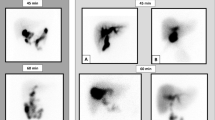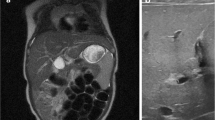Abstract
A 39-year-old woman with acute cholecystitis and gallstones underwent laparoscopic cholecystectomy. She suffered from recurrent episodes of cholangitis due to injury of the major bile ducts during laparoscopic cholecystectomy.
Hepatobiliary scintigraphy with Tc-99m Sn-N-pyridoxyl-5-methyltryptophan was performed. Although normal bile excretion was found from the left hepatic duct to the percutaneous transhepatic biliary drainage (PTBD) tube, excretion from the right hepatic lobe was prolonged. Scintigraphy with Tc-99m diethylenetriaminepentaacetic acid-galactosyl human serum albumin demonstrated atrophy of the right hepatic lobe and enlargement of the left hepatic lobe. Cholangiography via the PTBD tube revealed complete obstruction of the left hepatico-jejunal anastomosis and could not enhance the right intrahepatic bile duct. A right hepatic lobectomy was performed because of the atrophy, glissonitis and the absence of an appropriate bile duct for reconstruction. Postoperatively she was active and exhibited no evidence of recurrent cholangitis.
Similar content being viewed by others
References
Ponsky JL. Complications of laparoscopic cholecystectomy.Am J Surg 161: 393–395, 1991.
Rossi RL, Schirmer WJ, Braash JW, Sanders LB, Munson JL, Jenkins R, et al. Laparoscopic bile duct injuries: Risk factors, recognition and repair.Arch Surg 127: 596–602, 1992.
Raute M, Podle P, Jaschke W, Manegold BC, Trede M, Chir B. Management of bile duct injuries and strictures following cholecystectomy.World J Surg 17: 553–562, 1993.
Deziel DJ, Millikan KW, Economou SG, Doolas A, Ko ST, Airan MC. Complications of laparoscopic cholecystectomy: A national survey of 4292 hospitals and an analysis of 77604 cases.Am J Surg 165: 9–14, 1993.
Schimpl G, Aigner R, Sorantin E, Mayr J, Sauer H. Comparison of hepaticoantrostomy and hepaticojejunostomy for biliary reconstruction after resection of a choledochal cyst.Pediatr Surg Int 12: 271–275, 1997.
Eikman ED. Radionuclide hepatobiliary procedures; When can HIDA help?J Nucl Med 20: 358–361, 1979.
Yen S-H, Liu O-K, Huang M-J. Sequential scintiphotography with technetium-99m pyridoxylidene glutamate in the detection of intrahepatic lithiasis: Concise communication.J Nucl Med 21: 17–21, 1980.
Oshita M, Yasukochi H. Bile leakage after laparoscopic cholecystectomy demonstrated with99mTc-PMT hepatobiliary scintigraphy.Ann Nucl Med 7: 265–267, 1993.
Aburano T, Kuwajima A, Ishida H, Tonami N, Hisada K, Matsudaira M. Hepatobiliary scintigraphy in segmental biliary obstruction.KAKU IGAKU (Jpn J Nucl Med) 21: 311–317, 1984.
Wang C-S, Chen P-H, Siau C-P. Diagnosis of intrahepatic stones by Tc-99m pyridoxylidene glutamate cholescintigram.J Formosan Med Assoc 77: 525–532, 1978.
Kudo M, Todo A, Ikekubo K, Hino M. Receptor index via hepatic asialoglycoprotein receptor imaging: Correlation with chronic hepatocellular damage.Am J Gastroenterol 87: 865–870, 1992.
Koizumi K, Uchiyama G, Arai T, Ainoda T, Yoda Y. A new liver functional study using Tc-99m DTPA-galactosyl human serum albumin: Evaluation of the validity of several functional parameters.Ann Nucl Med 6: 83–87, 1992.
Wu J, Ishikawa N, Takada T, Tanaka Y, Pan QX, Sato M, et al. The functional hepatic volume assessed by99mTc-GSA hepatic scintigraphy.Ann Nucl Med 9: 229–235, 1995.
Shiomi S, Kuroki T, Kuriyama M, Takeda T, Nishiguchi S, Nakajima S, et al. Evaluation of fulminant hepatic failure by scintigraphy with technetium-99m-GSA.J Nucl Med 38: 79–82, 1998.
Nakajima K, Kinuya K, Mizutani Y, Hang E-H, Michigishi T, Tonami N, et al. Simple scintigraphic parameters with Tc-99m galactosyl human serum albumin for clinical staging of chronic hepatocellular dysfunction.Ann Nucl Med 13: 5–11, 1999.
Nishiguchi S, Shiomi S, Sasaki N, Iwata Y, Mikami S, Tanaka H, et al. Course before and after percutaneous transhepatic portal vein embolization of a patients with cholangiocarcinoma monitored by scintigraphy with Tc-99m galactosyl human serum albumin.Ann Nucl Med 14: 231–234, 2000.
Inoue Y, Machida K, Honda N, Mamiya T, Takahashi T, Kamano T, et al. Impaired hepatic function in segmental biliary obstruction demonstrated with a receptor-binding radiotracer.Ann Nucl Med 8: 209–212, 1994.
Author information
Authors and Affiliations
Corresponding author
Rights and permissions
About this article
Cite this article
Nishiguchi, S., Shiomi, S., Sasaki, N. et al. A case of recurrent cholangitis after bile duct injury during laparoscopic cholecystectomy: Value of scintigraphy with Tc-99m GSA and hepatobiliary scintigraphy for indication of lobectomy. Ann Nucl Med 14, 383–386 (2000). https://doi.org/10.1007/BF02988702
Received:
Revised:
Issue Date:
DOI: https://doi.org/10.1007/BF02988702




